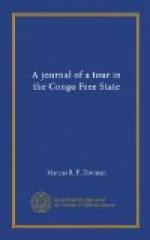The villages in the neighbourhood of Coquilhatville seem very populous and prosperous. Any morning early whole families can be met—father, mother and children, with bundles of manioc fastened on their backs by broad grass fibres—going to the town. Everywhere the natives seem contented and happy. When not working, they sit in the roads and dye their skins or have their hair dressed, while the children play around with bows and arrows or other pugnacious kind of toys. The wealthy wear heavy brass rings extending from the ankle to the knee and the discomfort must be very great, but as is proved by the tatouage, the natives will bear much pain in order to beautify themselves. Before leaving Coquilhatville, we send for the boy Epondo, who was rendered famous as an example of an atrocity by Mr. Casement, the late British Consul at Boma. Epondo is now employed as a gardener by the Commissaire of the District and is always at hand when visitors desire to see him. Four inches below the elbow joint of the left arm there are two deeps scars, three inches apart, which could certainly have been produced by the bite of an animal of about the size of a wild boar. The stump of the forearm is covered with irregular scars, such as would remain if the hand had become gangrenous and fallen away. It was useless asking him questions, as he had already told two distinct stories which have been related above.
On August 10th, we leave Coquilhatville and steam down the river to Irebu, which we reach after a few hours hot journey. Mr. Jeniaux, the Commandant, has spared no pains to make the camp not only beautiful but attractive in every way and it has well earned its reputation as one of the show places of the Congo. Lord Mountmorres is lodged in a spare house used for guests and Lieutenant Hoyer kindly lends me his during our stay. The Mess is very comfortably arranged, and the dinner based on antelope and wild pig is excellent.
Next day I go hunting with Mr. Hoyer in a canoe propelled by twenty paddlers. These at first keep up a kind of chant to the time of the paddles which is quite musical and pleasant. As we approach the game grounds however, they become quite silent. After travelling up stream for about a mile, we land in a kind of bog which is full of a species of duck, somewhat resembling a wood-cock. A sergeant of the Force Publique acts as guide and hunter, and it soon becomes apparent that the native is in the habit of stalking even birds and shooting them sitting. This is natural enough for formerly they were armed with bows and arrows, and now the army of course use only rifles. Shot guns, therefore, are only known to the boys of the white men, some of whom are very good shots. The hunter seems quite annoyed because I only shoot at birds on the wing, but is delighted when one falls. So far indeed, the only enthusiasm a native has shown, has been while hunting after a successful shot. The paddlers at once re-enact




